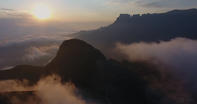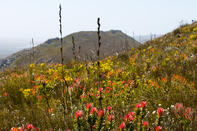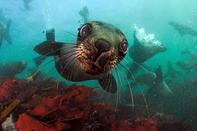Diverse Landscape
South Africa is a land of incredible natural beauty, with more than three million ha set aside for conservation. From the enormous, world-renowned, game-rich Kruger National Park to the tiny, botanically diverse Mkambati Nature Reserve in the Eastern Cape, the landscape offers a wealth of natural experiences.

Most of South Africa is situated on a high central plateau with narrow coastal plains extending from the escarpment to the sea. On the east coast of the Indian Ocean, the southward-flowing warm Mozambique Current brings dependable rain to the coastal plains.
As a result, South Africa has lush forests and bushveld on the east coast and along the escarpment. Once on the central plateau, the rainfall decreases steadily towards the west until, on the west coast, South Africa has semi-desert conditions.
The Atlantic Ocean on this coast is cooled by the Benguela Current, which flows northwards from the Antarctic and so does not bring much rain. But it is one of the richest sources of fishing in the world.
Right in the southwest corner of the country, the Western Cape is somewhat anomalous. Rainfall here is in winter and is brought by huge cyclonic weather systems. The summers are warm and dry and, generally the whole floral and faunal assemblage is unique.
Indigenous Vegetation and High Biodiversity

The southwestern part of the Western Cape consists of the Cape Floral Kingdom - or as South Africans colloquially call it - fynbos, which literally means ‘fine bush’ for its small leaves and flowers. Further north and east is the Karoo semi-desert and, to the northwest, the arid but beautiful Namaqualand. Along the east coast are pockets of coastal forest.
The escarpment consists mostly of Afro-montane grassland, with some pockets of Afro-montane forest. The broad central highveld consists of mostly open grassland and the lowveld consists of broad-leaved open canopy woodland with large areas of grass. The far northwest of the country is desert.
With the enormous diversity of vegetation zones and types, South Africa has the third highest biodiversity in the world after Brazil and Indonesia. South Africans are proud of conservation management and want to share it with visitors. South Africa is the best place in the world to watch big game.
Unlike many other countries, where elephant herds are dwindling and rhinos are practically extinct, South Africa has extremely healthy populations of these and most of the other animals you would expect to see on safari in Africa. The country also has over 900 species of birds, many of which are found in the national parks.
Excellent Diving and Whale Watching Opportunities

South Africa has over 3 000 km of coastline and an enormous range of sea life. Avid divers can travel up the coast in about two weeks and dive in a wide range of marine environments, seeing a totally different faunal and floral assemblage in each spot.
And if you would prefer to stay on the surface, you can still see an incredible array of marine life. South Africa is undoubtedly one of the most fantastic marine mammal watching destinations in the world.
You can spot Cape fur seals on a short boat trip from most of the major seaside towns in the Western Cape and Garden Route, and enormous pods of bottlenose dolphins regularly swim up and down the coast.
The beautiful and unusual dusky dolphin is quite common near Cape Town. Common dolphins are quite common, and humpback dolphins are seen quite often from Plettenberg Bay north and east to Maputaland.
Southern right whales are a familiar sight in many places off the Cape coast between June and November, and humpback whales are often spotted between August and December. Brydes whales are regularly spotted and orcas are also seen occasionally.
 South Africa's incredible biodiversity is due to its unique physical features. Most of the country is situated on a high-lying plateau, betw...
South Africa's incredible biodiversity is due to its unique physical features. Most of the country is situated on a high-lying plateau, betw... South African forests are not nearly as extensive as they once were, but there are some remaining stands of beautiful old forest....
South African forests are not nearly as extensive as they once were, but there are some remaining stands of beautiful old forest.... For a few weeks over August and September, the area stretching north and west from Cape Town is transformed in a colourful and spectacular f...
For a few weeks over August and September, the area stretching north and west from Cape Town is transformed in a colourful and spectacular f... SouthAfrica.co.za provides readers with educational information in our South African Nature Guide on marine life, mammals, reptiles, birds, ...
SouthAfrica.co.za provides readers with educational information in our South African Nature Guide on marine life, mammals, reptiles, birds, ...